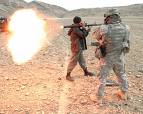How Many U.S. Troops To Stay In Afghanistan And For How Long?

One thing should always be remembered: the US does not (and never was) intend to leave Afghanistan at all. The country is too crucial for the US strategy of the “Greater Middle East”, and, being located in a strategic vicinity to Iran, Central and South Asia, it allows to exert pressure on a vast area.
[S]taying in Afghanistan for as long as possible and still longer is what the Americans are determined to do. But the question is: how long will Afghanistan and its neighbors tolerate the occupation?
On December 12, 2012, the US Defense Secretary Leon Panetta arrived in Afghanistan on an unannounced visit. On the first day of his two-day stay in the country he met with the top US military commanders there and discussed options on how many troops to keep in Afghanistan after the NATO mission ends in 2014.
President Barack Obama’s decision on the issue is expected in the coming weeks.
Officially, the number of troops the US wants to keep in Afghanistan is not disclosed, but experts believe that it may be 6,000 to 10,000 of the current 66,000 to 68,000.
In any case, the number of troops that will remain in the country after the withdrawal is over should be sufficient to sustain up to five military bases in crucial parts of Afghanistan.
The proposed bases include:
– one at Bagram near Kabul;
– one at Shindand in the west, near the Iranian border;
– one at Mazar-i-Sharif in the north;
– one or two in the south (Kandahar and/or Helmand).
The visit and the topics discussed leave no doubt that the previously announced “full withdrawal” of US troops from Afghanistan was from the very beginning meant for the internal consumption by the credulous American public.
One thing should always be remembered: the US does not (and never was) intend to leave Afghanistan at all. The country is too crucial for the US strategy of the “Greater Middle East”, and, being located in a strategic vicinity to Iran, Central and South Asia, it allows to exert pressure on a vast area.
There still remain doubts on whether the strategic goal is easily achievable.
It should be noted that despite the announcement widely publicized when Leon Panetta just landed in Afghanistan that, apart from the US military top brass, he is going to meet with Afghan President Hamid Karzai, by Thursday mid-afternoon no reports of such a meeting were available.
Definitely, even if such a meeting did take place, there are too many problems in the US relationship with the present Afghan leadership to be overcome too easily. Hamid Karzai was installed as Afghan president by the US as a servile marionette. But even being one, he cannot totally ignore the arrogance of the occupation forces that have alienated the whole of Afghan society and not only the Taliban they were supposed to fight with.
Not only weren’t the Taliban defeated – on the contrary, the movement is gaining strength and now even the current Afghan authorities have to agree that the Taliban can participate in power-sharing and even govern parts of Afghanistan, namely in the east and in the south of the country.
It is also noteworthy that on the day of Leon Panetta’s arrival in Afghanistan, President Karzai was in Turkey participating in trilateral talks with Turkish and Pakistani leaders. The talks are widely looked upon as an attempt to substitute Islamabad for Washington as the chief coordinator of the post-war reconciliation process.
As for the particular issue of future US military presence in Afghanistan, Hamid Karzai is probably unable to resist it, but on many occasions he has expressed his demand that American forces come under the jurisdiction of Afghan courts. It should be noted that similar demands made by Iraqi authorities eventually forced Americans to leave that country altogether.
Also, Karzai has been demanding that the US hand over custody of all detainees held at Bagram prison and has warned that his government might suspend negotiations on the future US force.
All these reservations come from a government that is still regarded as West-friendly. But 2014 is not just the year of Western troop withdrawal, but also the year of general elections in Afghanistan. And no one can say for sure whether the US will succeed in holding another fraudulent election and implanting another obedient marionette, or whether the practice of “colored revolutions” the US strategists are so fond of will backfire against them.
So, the attempts by Leon Panetta and other topmost US officials to present a rosy picture of the situation in Afghanistan once again represent an example of wishful thinking. Of course, staying in Afghanistan for as long as possible and still longer is what the Americans are determined to do. But the question is: how long will Afghanistan and its neighbors tolerate the occupation?
Boris Volkhonsky, senior research fellow, Russian Institute for Strategic Studies
http://groups. yahoo.com/ group/stopnato/ messages
Stop NATO website and articles:
http://rickrozoff. wordpress. com

